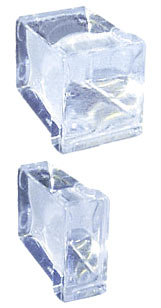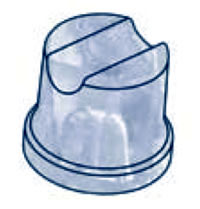Cubers Self Contained
The most common form of ice in the commerical industry. Eighty percent of restaurants choose ice machines that make cubed ice.
Cube ice is clear and comes in various shapes —rectangular, full cube, half cube, gourment, contour, or other regular shapes. The largest dimension is about 1.25 inches (3.18 centimeters). Pieces of cube ice range in weight from 1/6 to 1/2 ounce (4.8 to 14.0 grams) and contain minimal amounts of liquid water.
 Full Cube or Half Cube
Full Cube or Half Cube
Half Cube- This smaller, easier-to-handle ice is perfect for blended drinks due to its ability to break down and create a smoother finish.
Half cube ice is easily delivered by our machines for consistent
production and works well in dispenser applications.
Dimensions: width: 3/8 in., depth: 7/8 in., height: 7/8 in.
Full Cube- As the perfect complement to any cocktail or beverage, drinks simply look and taste better with this long-lasting, classic ice
cube. Full cube ice is the most popular choice for large-volume
applications like bagging and bulk cooling.
Dimensions: width: 7/8 in., depth: 7/8 in., height: 7/8 in.
Advantages- It is slow melting and fills a glass better. This means more savings for you and a cooler, better quality drink for your customers.
Uses it for - Mixed Drinks, Carbonated dinks, Ice retailing, Salad bars, and Ice dispensing.
 Gourmet Cube
Gourmet Cube
Shape- Usually resemble a top hat or are shaped like a small shot glass.
Advantages- Size eliminates clumping and allows for easy filling of a glass. Easy to scoop, the hard slow melting cube makes them ideal for re-icing glasses. The distinctly attractive look, make it perfect for use in mixed drinks and gourmet drinks.
Uses for it- Bar use, Upscale restaurants, Banquet service, and Waitress stations.
![]()
Air-Cooled vs Water -Cooled Ice Makers
The choice of an air-cooled or water-cooled machine is an important one. The first thing to consider is the environment where your ice machine will be located. Temperature and air circulation, effects your ice machine's performance and efficiency.
Air-Cooled
An air-cooled ice maker is more affordable, and can be installed anywhere you have access to water and electricity. The down side is they use more energy, can exhaust significant amounts of heat, and are too noisy to be located close to customer service areas.
Air-cooled ice makers should not be used in a small room without air circulation. It needs to have 6” of clearance on all air intake and discharge areas. As a rule of thumb, a 10°F air temperature increase may reduce daily ice production by 10% when using an air-cooled machine. It is not recommend for small kitchens where the ice machine must be located near the cooking equipment and air temperatures are typically over 80F. The increased room temperature will melt ice in the bin quicker, requiring more ice-making capacity to replenish and fill the bin.
Water-Cooled
A water-cooled ice maker generates less heat, uses less electricity, and is quieter than air-cooled machines. Water-cooled units are more efficient than air-cooled units and great for environments where high water and ambient air temperatures would virtually shut down an air cooled machine.
The problem is that these machines are not allowed in certain areas because of the cost of the water. In most areas, water-cooled machines must be on a closedloop systems, meaning no water can be dumped down a drain. A closed loop and cooling tower may or may not be feasible in a smaller restaurant.
Generally, a water-cooled unit should only be chosen if one or more of the following conditions exists where the machine will be installed:
• Ambient air temperatures of more than 80°F
• Air contains a high level of contaminants such as grease
• A lack of air circulation
The Bottom Line
Air-cooled ice makers use the most energy—5.4 to 22.5 kWh per 100 pounds of ice—but cost
less than water-cooled models and use less water.
Water-cooled ice makers are more efficient than air-cooled units, using 4.7 to 14.2 kWh per 100
pounds of ice. The heat removed in making the ice is discharged outside the building, so air-conditioning costs are not affected.


